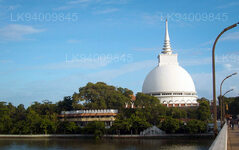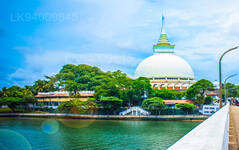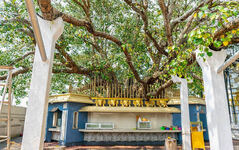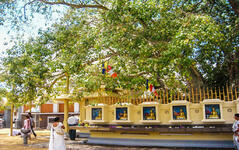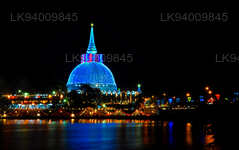
Kalutara City
Kalutara is a coastal city in western Sri Lanka, known for its serene beaches and historic sites. The iconic Kalutara Bodhiya, a sacred Buddhist stupa, and the Richmond Castle, a colonial mansion, are prominent attractions. The city blends cultural richness with natural beauty.
Kalutara Bodhiya
The Kalutara Bodhiya is an ancient Bo tree which was identified as one of the 32 saplings of the original Jaya Sri Maha Bodhi planted during the reign of king Devanampiyatissa in Anuradhapura during the 2nd century BC. It remains as a very important historical site to this day.
History
According to history that the Bo tree at Kalutara sprouted from a sapling of the Jaya Sri Maha Bodhi (The Great Resplendent Fig Tree Symbolising Victory) in Anuradhapura; which itself is a sapling of the very Bo Tree (Ficus religiosa) in Bihar, Madhya Pradesh, India underneath which Buddha attained enlightenment.
The First Tree
The story of how this tree came to Kalutara is quite interesting. The Bo Tree at Buddha Gaya became a subject of veneration after Prince Siddhartha Gautama attained enlightenment while seated under its spreading branches. Centuries later the tree became a symbol of the Buddha’s presence and therefore became worshipped. A sapling of the original tree was brought to Sri Lanka by the bhikkhunī Sanghamitta, daughter of the King Asoka and twin sister of the Venerable monk Mahinda who brought Buddhism to Sri Lanka. The sapling was planted in the Mahamehavana Park of Anuradhapura in 288 AD. This became the Sri Maha Bodhi. As the original tree in Bihar was destroyed later on, it is a historical fact that the Sri Maha Bodhi is the world’s oldest tree with a documented history.
The Sapling
The history of the Sri Maha Bodhi tree is recorded in the Sinhalese literary Bo Tree classic, Bodhivamsa. According to this book the tree bore eight fruits. There were four saplings grew from the seeds of each fruit, making up a total of 32 saplings. Apparently the places that they were to be planted were specified by Mahinda himself and Kalutara was one of these places. However, the tree only survived until the 15th century AD.
The Buddhist public started to consider the location place sacred after a Pandyan prince named Wickrama Pandyan also planted a Bo tree on the current Lower Terrace of the Kalutara Bodhi premises in 1042 AD. The prince served as a viceroy in the Kalutara area during that period, and wished to get the support of the locals though he was a Hindu himself. During the 15th century invasion by the Portuguese, care for the tree decreased and the tree died. However, it regrew a few decades later. After the Portuguese took control of the coastal provinces of Sri Lanka in the 16th century, they noticed that the site was popular with the locals, and possibly decided that it could be used strategically to control the religious activities of the people there. The site of the Kalutara Bodhiya was converted into a fort during this time.
After the Portuguese, the Dutch and the English who made Sri Lanka their conquest also used the same premises for administrative and military purposes. It was during the 19th century that disaster almost befell the tree. When the British government started to construct railroads in Sri Lanka they decided to remove the large obstruction formed by the tree in order to build the Kalutara Railway bridge. But, after vehement protests made by the Buddhist public who were led by Sandanayake Upasaka – a Buddhist layman in Kalutara area, it was later decided that the bridge would be constructed without harming the Bodhi tree.
The Kalutara Bodhiya Trust
Kalutara Bodhiya was developed as a religious place in modern times when the Kalutara Buddhist Society formed in 1931.The society was created so as to take care of the welfare of the Buddhists and the development of Buddhism in the Kalutara area. After the country gained independence in 1948, Sir. Cyrill de Soysa , a prominent lawyer, senator and notary public, requested the newly appointed government led by Prime Minister D. S. Senanayake to take measures to remove other establishments the Kalutara Bodhiya site so as to use the place only for religious purposes.
In 1942 construction commenced on the lower terrace; the pinnacle of the Bo shrine was laid. The first foundation stone was laid for the construction of the great shrine on the Upper Terrace in 1964. By 1976, the construction work on the massive stupa was completed and opened to the public.
The Kalutara Bodhi Trust (KBT) was established by Sir Cyril de Zoysa with the help of six other lawyers on November 7, 1951. Their objective was the “Protection and Nurturing of Historic Kalutara Bodhiya”. Sir Ernest de Silva became the first chairman. Presently the trust serves as a non-profit organization which provides services throughout Sri Lanka. In addition to its main objective, it also works to alleviate poverty and give humanitarian assistance to the needy sectors of the local population, and to achieve sustainable development and welfare of the society. In addition to that, KBT is also involved in conducting Blood Donation Campaigns and events to save cattle from death on every other Poya day.
About Kalutara District
Kalutara is situated approximately 42km south of Colombo. Once a spice trading post, Kalutara was controlled variously by the Portuguese, Dutch and British. The town is famous for quality bamboo basket and mats and the most luscious mangosteens.
The 38-meter long Kalutara Bridge was built at the mouth of the Kalu Ganga River and serves as a major link between the country's Western and Southern border. At the southern end of the bridge lies the 3 stories-high Kalutara Vihara, a Buddhist temple built in the 1960s which holds the distinction of being the only stupa in the world that is hollow.
About Western Province
The Western Province is the most densely populated province of Sri Lanka. It is home to the legislative capital Sri Jayawardenapura as well to Colombo, the nation's administrative and business center. Western Province is divided into 3 main districts called Colombo (642 km²), Gampaha (1,386.6 km²) and Kalutara (1,606 km²) districts. As Sri Lanka's economic hub, all the major local and international corporations have their presence in the city and so do all the major designer and high street retailers, so be ready to indulge in some retail therapy in western province.
Having the highest population in the all the provinces, the almost all the premier educational institutions in the island are located in western province. Universities in the province include the University of Colombo, the University of Sri Jayewardenepura, University of Kelaniya, Open University, Sri Lanka, Buddhist and Pali University of Sri Lanka, General Sir John Kotelawala Defence University and University of Moratuwa .Western province has the largest amount of schools in the country, which includes National, Provincial, Private and International schools.

